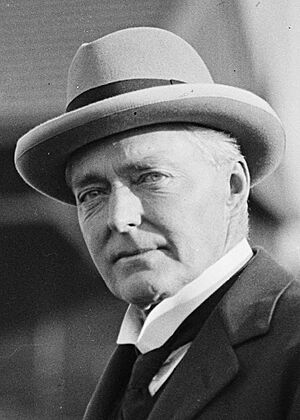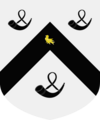Henry Forster, 1st Baron Forster facts for kids
Quick facts for kids
The Lord Forster
|
|
|---|---|

Forster c. 1925
|
|
| 7th Governor-General of Australia | |
| In office 6 October 1920 – 8 October 1925 |
|
| Monarch | George V |
| Prime Minister | Billy Hughes Stanley Bruce |
| Preceded by | Sir Ronald Munro Ferguson |
| Succeeded by | The Lord Stonehaven |
| Member of Parliament for Bromley |
|
| In office 30 December 1918 – 12 December 1919 |
|
| Preceded by | New constituency |
| Succeeded by | Cuthbert James |
| Member of Parliament for Sevenoaks |
|
| In office 26 July 1892 – 30 December 1918 |
|
| Preceded by | Charles Mills |
| Succeeded by | Sir Thomas Bennett |
| Personal details | |
| Born | 31 January 1866 Catford, Kent, England |
| Died | 15 January 1936 (aged 69) London, England |
| Political party | Conservative |
| Spouse | Rachel Cecily Douglas-Scott-Montagu (m. 1890) |
| Children | 4 |
Henry William Forster, 1st Baron Forster (born 31 January 1866 – died 15 January 1936) was an important British politician. He served as the seventh Governor-General of Australia from 1920 to 1925. Before this, he was a government minister under several Prime Ministers, including Arthur Balfour and David Lloyd George.
Forster was born in Catford, a town in Kent, England. He went to famous schools like Eton College and New College, Oxford. When he was young, he was a talented cricketer. Later in life, he even became the president of the Marylebone Cricket Club, a very important cricket club. In 1892, Forster was elected to the House of Commons as a member of the Conservative Party. He held various government jobs, like a Junior Lord of the Treasury and Financial Secretary to the War Office. In 1919, he was given a special title, becoming a Baron. The next year, he was chosen to be the Governor-General of Australia. During his time in Australia, he mostly focused on public events and was well-liked by people. He returned to England after his five-year term ended.
Contents
Early Life and Love for Sports
Henry Forster was born at Southend Hall in Catford, Kent. His father, Major John Forster, was an Army officer. Henry went to Eton College and later to New College, Oxford.
He was a very good cricketer. He played for Oxford University and Hampshire. He was a right-handed batsman and a left-arm spin bowler. He even became the president of the Marylebone Cricket Club, which shows how respected he was in the sport. Besides cricket, he also loved yachting (sailing boats) and horse-racing.
A Career in British Politics
Forster started his political career in 1892. He became a Member of Parliament (MP) for Sevenoaks. He held this seat until 1918. After that, he was elected for a new area called Bromley.
In 1901, he was given the role of a deputy lieutenant for Kent. From 1902 to 1905, he worked as a Junior Lord of the Treasury in the government led by Arthur Balfour. This role involved helping with financial matters. Later, from 1915 to 1919, he was the Financial Secretary to the War Office. This meant he managed the money for the army during the First World War. In 1919, he was given a special noble title, becoming Baron Forster.
Serving as Governor-General of Australia
In June 1920, Henry Forster was offered the important job of Governor-General of Australia. He accepted the role. Soon after, he received a high honour, becoming a Knight Grand Cross of the Order of St Michael and St George (GCMG).
This was a special appointment because, for the first time, the Australian government was truly asked for their opinion. The British government suggested a few names, and the Australian Prime Minister, Billy Hughes, approved of Forster. Hughes seemed to prefer Forster because he thought Forster was a modest person he could work well with. Forster's reputation as a sportsman was also a plus.
Forster arrived in Australia in October 1920. He found that Australian politics had become quite tense after the First World War. The Nationalist Party was very strong. The Labor Party had changed and was now against the British Empire and war.
However, Forster did not get involved much in Australian politics during his five years there. There was only one change in government while he was in office. Billy Hughes was replaced by Stanley Bruce in 1923. Forster did not play a part in these political changes. As Australia became more independent, the Governor-General's role became less about overseeing and more about representing. Forster was not a strong personality like his predecessor, so he accepted this new, less powerful role.
Instead, Forster's job became more like what a modern Governor-General does today. He would open events, visit hospitals, attend sports games, and host parties. Because of this, he became much more popular than many of the Governors-General before him. However, he had less real power. Forster and his wife, Rachel, spent a lot of time helping charities. Forster also traveled a lot around Australia, visiting different states and country areas. He would unveil war memorials and give patriotic speeches. He became known as a "decorative" Governor-General, meaning he was more about public appearances than political decisions.
In 1925, a new hospital for women in Redfern, Sydney, was named the "Rachel Forster Hospital for Women" in honour of Lady Forster. There is also a "Lady Forster Kindergarten" in Elwood, Victoria, named after her because she was a big supporter of it.
The Forsters left Australia in October 1925. They were well-liked by the public.
Family Life and Later Years
Lord Forster married Rachel Cecily Douglas-Scott-Montagu on 3 June 1890. She was the daughter of the 1st Baron Montagu of Beaulieu.
After their time in Australia, they settled near Southampton in England. They lived a quiet life until Forster passed away in 1936. Lady Forster was also given a special honour in 1926, becoming a Dame Grand Cross of the Order of the British Empire (GBE). She also received an honour from the Order of St. John of Jerusalem.
Henry and Rachel Forster had two sons, John and Alfred. Sadly, both of their sons were killed during the First World War. They also had two daughters, Dorothy and Emily Rachel Forster. Emily married George Pitt-Rivers. Because Lord Forster had no sons who survived him, his special title of Baron Forster ended when he died.
Henry Forster passed away in London on 15 January 1936, at the age of 69. Rachel, Lady Forster, lived much longer and died on 12 April 1962, at the age of 93.
Images for kids



